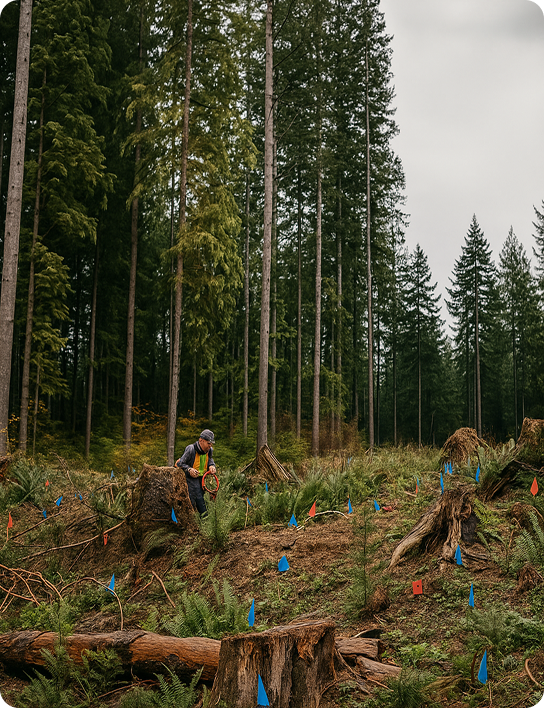CONTACT US
Let’s Restore the
World Together.

Ready to restore ecosystems at scale?
If you’re a policymaker, investor, land steward, or NGO, we’d love to hear from you. Let’s turn reforestation into a scalable solution — now.
Do you have questions?
Who is TreeTrack?
TreeTrack is a Vancouver-based AgTech company specializing in large-scale, sustainable forest restoration. We utilize precision aerial seeding technology, combining site assessment, custom-engineered Seedpods, and advanced dispersal mechanisms to effectively restore ecosystems, particularly in landscapes impacted by wildfire.
How does TreeTrack’s aerial seeding technology work?
Our system employs AI-driven drones to deploy custom-formulated Seedpods with high germination and resilience. These drones ensure precise, one-by-one Seedpod drops, optimizing spacing and placement based on soil, moisture, and terrain conditions. This targeted approach maximizes establishment rates and ensures efficient coverage.
What distinguishes TreeTrack from traditional aerial seeding?
Traditional methods often have low success rates. TreeTrack’s technology, verified by third-party evaluations, achieves establishment rates 8 to 10 times higher than conventional approaches. Our use of advanced AI and machine learning ensures precise seed placement, leading to more effective and efficient ecosystem recovery.
Who are TreeTrack’s clients?
We collaborate with government agencies, NGOs, private companies, and First Nations communities seeking scalable, eco-friendly solutions, especially in areas affected by wildfire requiring rapid landscape regeneration.
What partnerships does TreeTrack have?
TreeTrack partners with organizations like Tree Canada and various First Nations communities. We work to restore lands impacted by wildfires at no cost to these communities, funded through partnerships and ESG-focused investments.
What makes TreeTrack’s Seedpods unique?
Our patent-pending Seedpods are designed for optimal germination and resilience. They contain organic binders and fertilizers, are tailored for specific species, and are formulated to retain moisture, protect seeds from rodents, and enhance successful establishment.
What environmental benefits does TreeTrack offer?
Our land restoration efforts aim to reduce carbon emissions, restore natural habitats, and support biodiversity recovery. By deploying efficient aerial seeding technology, we can quickly cover large areas, making ecological restoration efforts more impactful and scalable.
How does TreeTrack collaborate with First Nations communities in Canada?
We partner with First Nations communities whose lands have been affected by wildfires, providing no-cost restoration services. These projects are funded through investments and partnerships with organizations supporting ESG initiatives.
How does TreeTrack assist landowners in the USA?
TreeTrack offers aerial land restoration services to landowners affected by wildfires in the USA, working in collaboration with local agencies and industry partners to efficiently and sustainably restore damaged ecosystems.
What is TreeTrack’s germination success rate?
Our Seedpods have demonstrated establishment rates 8 to 10 times higher than traditional aerial seeding methods. For detailed information, please contact our team.
How can investors or partners get involved with TreeTrack?
We welcome partnerships with organizations aligned with our mission of restoring degraded landscapes through ecological intelligence. Interested investors or partners can reach out to our team to discuss opportunities and learn how they can support our work.
How is TreeTrack’s work funded?
TreeTrack’s projects are funded through a combination of commercial projects, private investments, grants, and partnerships with ESG-focused companies and NGOs. We aim to expand these partnerships to fund more projects with significant social and environmental impact.
What species does TreeTrack plant, and how are they selected?
We plant a variety of native species suited to each project area’s ecosystem. Our team customizes Seedpod formulations based on the specific environmental conditions and species requirements of each site.
